Development of Nanosized Mn3O4-Co3O4 on Multiwalled Carbon Nanotubes for Cathode Catalyst in Urea Fuel Cell
Abstract
1. Introduction
| Anode: CO(NH2)2 + 6OH− → N2 + 5H2O+ CO2 + 6e− E0 = −0.746 V |
| Cathode: 2 H2O + O2 + 4e− → 4OH− E0 = 0.4 V |
| Overall: 2CO(NH2)2 + 3O2 → 2N2 + 4H2O + 2CO2 E0 = 1.146 V |
2. Materials and Methods
2.1. Preparation of Mn3O4-Co3O4/MWCNT Composite
2.2. Material Characterization
2.3. Electrochemical Measurements
2.4. Fabrication and Examination of Membrane Electrode Assembly
3. Results and Discussion
| Mn3+ + H2O2 → Mn2+ + HOO• + H+ | |
| HOO• + Mn3+ → Mn2+ + H+ + O2 | |
| Mn2+ + H2O2 → Mn3+ + HO• + OH− | |
| 2OH• → H2O + ½ O2 | |
| Overall: | H2O2 → H2O + ½ O2 |
4. Conclusions
Author Contributions
Funding
Acknowledgments
Conflicts of Interest
References
- Rollinson, A.N.; Jones, J.; Dupont, V.; Twigg, M.V. Urea as a hydrogen carrier: A perspective on its potential for safe, sustainable and long-term energy supply. Energy Environ. Sci. 2011, 4, 1216–1224. [Google Scholar] [CrossRef]
- Rollinson, A.N.; Rickett, G.L.; Lea-Langton, A.; Dupont, V.; Twigg, M.V. Hydrogen from urea-water and ammonia-water solutions. Appl. Catal. B 2011, 106, 304–315. [Google Scholar] [CrossRef]
- Zhan, S.; Zhou, Z.; Liu, M.; Jiao, Y.; Wang, H. 3D NiO nanowalls grown on Ni foam for highly efficient electro-oxidation of urea. Catal. Today 2019, 327, 398–404. [Google Scholar] [CrossRef]
- Yousef, A.; El-Newehy, M.H.; Al-Deyab, S.S.; Barakat, N.A.M. Facile synthesis of Ni-decorated multi-layers graphene sheets as effective anode for direct urea fuel cells. Arab. J. Chem. 2017, 10, 811–822. [Google Scholar] [CrossRef]
- Xu, W.; Wu, Z.; Tao, S. Urea-Based Fuel Cells and Electrocatalysts for Urea Oxidation. Energy Technol. 2016, 4, 1329–1337. [Google Scholar] [CrossRef]
- Lan, R.; Tao, S.; Irvine, J.T.S. A direct urea fuel cell—Power from fertiliser and waste. Energy Environ. Sci. 2010, 3, 438–441. [Google Scholar] [CrossRef]
- Sayed, E.T.; Eisa, T.; Mohamed, H.O.; Abdelkareem, M.A.; Allagui, A.; Alawadhi, H.; Chae, K.J. Direct urea fuel cells: Challenges and opportunities. J. Power Sources 2019, 417, 159–175. [Google Scholar] [CrossRef]
- Cao, D.; Chen, D.; Lan, J.; Wang, G. An alkaline direct NaBH4-H2O2 fuel cell with high power density. J. Power Sources 2009, 190, 346–350. [Google Scholar] [CrossRef]
- Xia, W.; Mahmood, A.; Liang, Z.; Zou, R.; Guo, S. Earth-Abundant Nanomaterials for Oxygen Reduction. Angew. Chem. 2016, 55, 2650–2676. [Google Scholar] [CrossRef] [PubMed]
- Chen, Z.; Waje, M.; Li, W.; Yan, Y. Supportless Pt and PtPd nanotubes as electrocatalysts for oxygen-reduction reactions. Angew. Chem. 2007, 46, 4060–4063. [Google Scholar] [CrossRef] [PubMed]
- Li, K.; Zhang, R.; Gao, R.; Shen, G.Q.; Pan, L.; Yao, Y.; Yu, K.; Zhang, X.; Zou, J.J. Metal-defected spinel MnxCo3-xO4 with octahedral Mn-enriched surface for highly efficient oxygen reduction reaction. Appl. Catal. B 2019, 244, 536–545. [Google Scholar] [CrossRef]
- Du, G.; Liu, X.; Zong, Y.; Hor, T.S.A.; Yu, A.; Liu, Z. Co3O4 nanoparticle-modified MnO2 nanotube bifunctional oxygen cathode catalysts for rechargeable zinc-air batteries. Nanoscale 2013, 5, 4657–4661. [Google Scholar] [CrossRef] [PubMed]
- Wang, Y.; Ma, X.; Lu, L.; He, Y.; Qi, X.; Deng, Y. Carbon supported MnOx-Co3O4 as cathode catalyst for oxygen reduction reaction in alkaline media. Int. J. Hydrog. Energy 2013, 38, 13611–13616. [Google Scholar] [CrossRef]
- Senthilkumar, N.; Gnana kumar, G.; Manthiram, A. 3D Hierarchical Core–Shell Nanostructured Arrays on Carbon Fibers as Catalysts for Direct Urea Fuel Cells. Adv. Energy Mater. 2018, 8, 1702207. [Google Scholar] [CrossRef]
- Liang, Y.; Li, Y.; Wang, H.; Zhou, J.; Wang, J.; Regier, T.; Dai, H. Co3O4 nanocrystals on graphene as a synergistic catalyst for oxygen reduction reaction. Nat. Mater. 2011, 10, 780–786. [Google Scholar] [CrossRef]
- Chai, H.; Xu, J.; Han, J.; Su, Y.; Sun, Z.; Jia, D.; Zhou, W. Facile synthesis of Mn3O4-rGO hybrid materials for the high-performance electrocatalytic reduction of oxygen. J. Colloid Interface Sci. 2017, 488, 251–257. [Google Scholar] [CrossRef]
- Huang, D.; Zhang, B.; Li, S.; Wang, M.; Shen, Y. Mn3O4/Carbon Nanotube Nanocomposites as Electrocatalysts for the Oxygen Reduction Reaction in Alkaline Solution. ChemElectroChem 2014, 1, 1531–1536. [Google Scholar] [CrossRef]
- Akbari, A.; Amini, M.; Tarassoli, A.; Eftekhari-Sis, B.; Ghasemian, N.; Jabbari, E. Transition metal oxide nanoparticles as efficient catalysts in oxidation reactions. Nano-Struct. Nano-Objects 2018, 14, 19–48. [Google Scholar] [CrossRef]
- Thangasamy, P.; Selvakumar, K.; Sathish, M.; Kumar, S.M.S.; Thangamuthu, R. Anchoring of ultrafine Co3O4 nanoparticles on MWCNTs using supercritical fluid processing and its performance evaluation towards electrocatalytic oxygen reduction reaction. Catal. Sci. Technol. 2017, 7, 1227–1234. [Google Scholar] [CrossRef]
- Liu, J.; Liu, J.; Song, W.; Wang, F.; Song, Y. The role of electronic interaction in the use of Ag and Mn3O4 hybrid nanocrystals covalently coupled with carbon as advanced oxygen reduction electrocatalysts. J. Mater. Chem. A 2014, 2, 17477–17488. [Google Scholar] [CrossRef]
- Ghosh Chaudhuri, R.; Paria, S. Core/shell nanoparticles: Classes, properties, synthesis mechanisms, characterization, and applications. Chem. Rev. 2012, 112, 2373–2433. [Google Scholar] [CrossRef] [PubMed]
- Menezes, P.W.; Indra, A.; González-Flores, D.; Sahraie, N.R.; Zaharieva, I.; Schwarze, M.; Strasser, P.; Dau, H.; Driess, M. High-Performance Oxygen Redox Catalysis with Multifunctional Cobalt Oxide Nanochains: Morphology-Dependent Activity. ACS Catal. 2015, 5, 2017–2027. [Google Scholar] [CrossRef]
- Zhao, T.; Gadipelli, S.; He, G.; Ward, M.J.; Do, D.; Zhang, P.; Guo, Z. Tunable Bifunctional Activity of MnxCo3−xO4 Nanocrystals Decorated on Carbon Nanotubes for Oxygen Electrocatalysis. ChemSusChem 2018, 11, 1248. [Google Scholar] [CrossRef]
- Duan, J.; Zheng, Y.; Chen, S.; Tang, Y.; Jaroniec, M.; Qiao, S. Mesoporous hybrid material composed of Mn3O4 nanoparticles on nitrogen-doped graphene for highly efficient oxygen reduction reaction. Chem. Commun. 2013, 49, 7705–7707. [Google Scholar] [CrossRef] [PubMed]
- Xiao, J.; Wan, L.; Wang, X.; Kuang, Q.; Dong, S.; Xiao, F.; Wang, S. Mesoporous Mn3O4-CoO core-shell spheres wrapped by carbon nanotubes: A high performance catalyst for the oxygen reduction reaction and CO oxidation. J. Mater. Chem. A 2014, 2, 3794–3800. [Google Scholar] [CrossRef]
- Jiang, Z.; Jiang, Z.J.; Maiyalagan, T.; Manthiram, A. Cobalt oxide-coated N- and B-doped graphene hollow spheres as bifunctional electrocatalysts for oxygen reduction and oxygen evolution reactions. J. Mater. Chem. A 2016, 4, 5877–5889. [Google Scholar] [CrossRef]
- Su, Y.; Zhu, Y.; Jiang, H.; Shen, J.; Yang, X.; Zou, W.; Chen, J.; Li, C. Cobalt nanoparticles embedded in N-doped carbon as an efficient bifunctional electrocatalyst for oxygen reduction and evolution reactions. Nanoscale 2014, 6, 15080–15089. [Google Scholar] [CrossRef]
- Duan, J.; Chen, S.; Dai, S.; Qiao, S.Z. Shape control of Mn3O4 nanoparticles on nitrogen-doped graphene for enhanced oxygen reduction activity. Adv. Funct. Mater. 2014, 24, 2072–2078. [Google Scholar] [CrossRef]
- Ma, T.Y.; Zheng, Y.; Dai, S.; Jaroniec, M.; Qiao, S.Z. Mesoporous MnCo2O4 with abundant oxygen vacancy defects as high-performance oxygen reduction catalysts. J. Mater. Chem. A 2014, 2, 8676–8682. [Google Scholar] [CrossRef]
- Dai, L.; Liu, M.; Song, Y.; Liu, J.; Wang, F. Mn3O4-decorated Co3O4 nanoparticles supported on graphene oxide: Dual electrocatalyst system for oxygen reduction reaction in alkaline medium. Nano Energy 2016, 27, 185–195. [Google Scholar] [CrossRef]
- Paulus, U.A.; Schmidt, T.J.; Gasteiger, H.A.; Behm, R.J. Oxygen reduction on a high-surface area Pt/Vulcan carbon catalyst: A thin-film rotating ring-disk electrode study. J. Electroanal. Chem. 2001, 495, 134–145. [Google Scholar] [CrossRef]
- Xin, S.; Guo, Y.G.; Wan, L.J. Nanocarbon networks for advanced rechargeable lithium batteries. Acc. Chem. Res. 2012, 45, 1759–1769. [Google Scholar] [CrossRef] [PubMed]
- Sonkar, P.K.; Prakash, K.; Yadav, M.; Ganesan, V.; Sankar, M.; Gupta, R.; Yadav, D.K. Co(II)-porphyrin-decorated carbon nanotubes as catalysts for oxygen reduction reactions: An approach for fuel cell improvement. J. Mater. Chem. A 2017, 5, 6263–6276. [Google Scholar] [CrossRef]
- Mu, J.; Wang, Y.; Zhao, M.; Zhang, L. Intrinsic peroxidase-like activity and catalase-like activity of Co3O4 nanoparticles. Chem. Commun. 2012, 48, 2540–2542. [Google Scholar] [CrossRef]
- Petlicki, J.; Palusova, D.; Van De Ven, T.G.M. Physicochemical aspects of catalytic decomposition of hydrogen peroxide by manganese compounds. Ind. Eng. Chem. Res. 2005, 44, 2002–2010. [Google Scholar] [CrossRef]
- Rhadfi, T.; Piquemal, J.Y.; Sicard, L.; Herbst, F.; Briot, E.; Benedetti, M.; Atlamsani, A. Polyol-made Mn3O4 nanocrystals as efficient Fenton-like catalysts. Appl. Catal. A 2010, 386, 132–139. [Google Scholar] [CrossRef]
- Valim, R.B.; Santos, M.C.; Lanza, M.R.V.; MacHado, S.A.S.; Lima, F.H.B.; Calegaro, M.L. Oxygen reduction reaction catalyzed by ε-MnO2: Influence of the crystalline structure on the reaction mechanism. Electrochim. Acta 2012, 85, 423–431. [Google Scholar] [CrossRef]
- Xu, J.; Gao, P.; Zhao, T.S. Non-precious Co3O4 nano-rod electrocatalyst for oxygen reduction reaction in anion-exchange membrane fuel cells. Energy Environ. Sci. 2012, 5, 5333–5339. [Google Scholar] [CrossRef]
- Greeley, J.; Stephens, I.E.L.; Bondarenko, A.S.; Johansson, T.P.; Hansen, H.A.; Jaramillo, T.F.; Rossmeisl, J.; Chorkendorff, I.; Nørskov, J.K. Alloys of platinum and early transition metals as oxygen reduction electrocatalysts. Nat. Chem. 2009, 1, 552–556. [Google Scholar] [CrossRef]
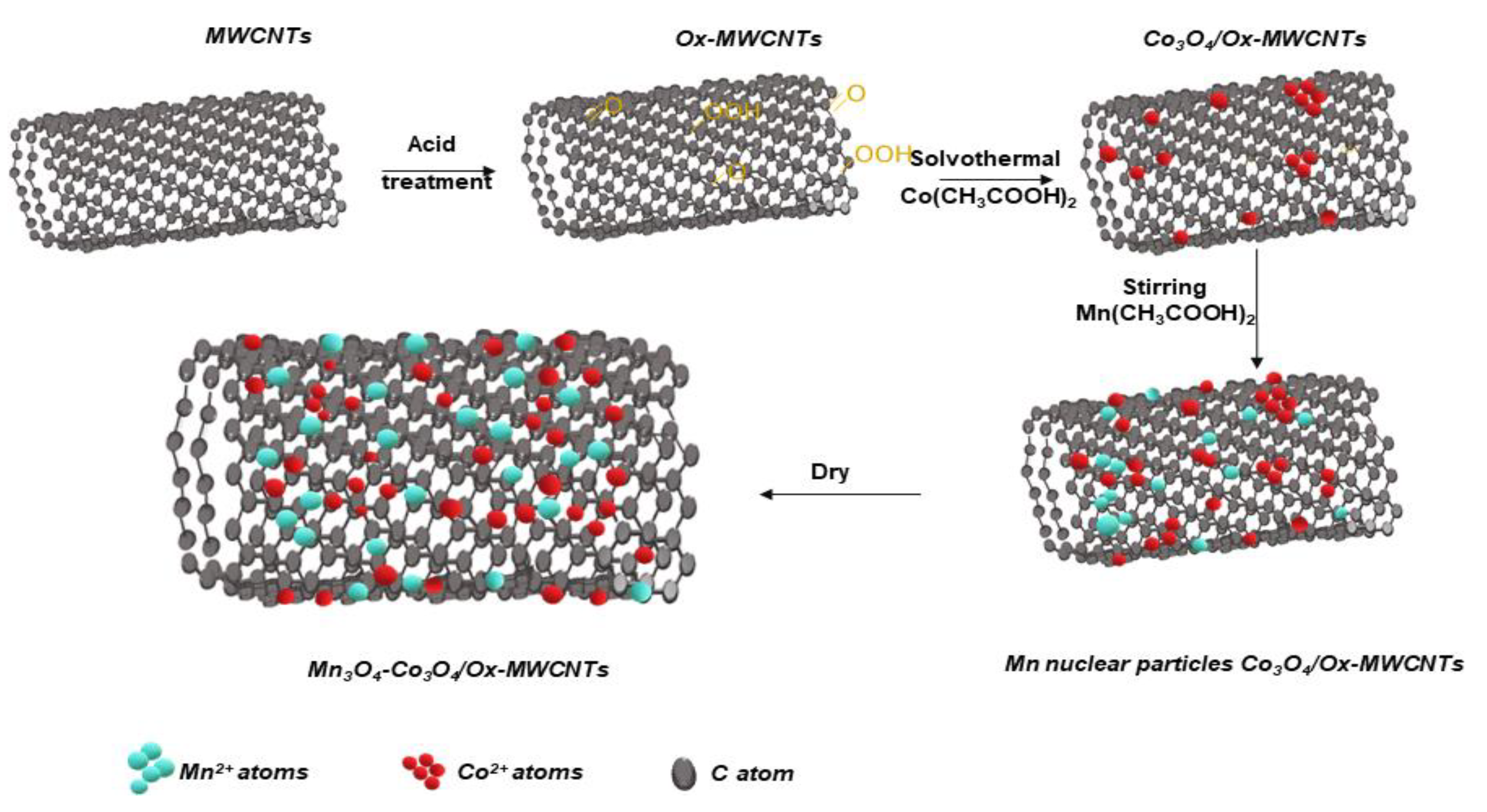

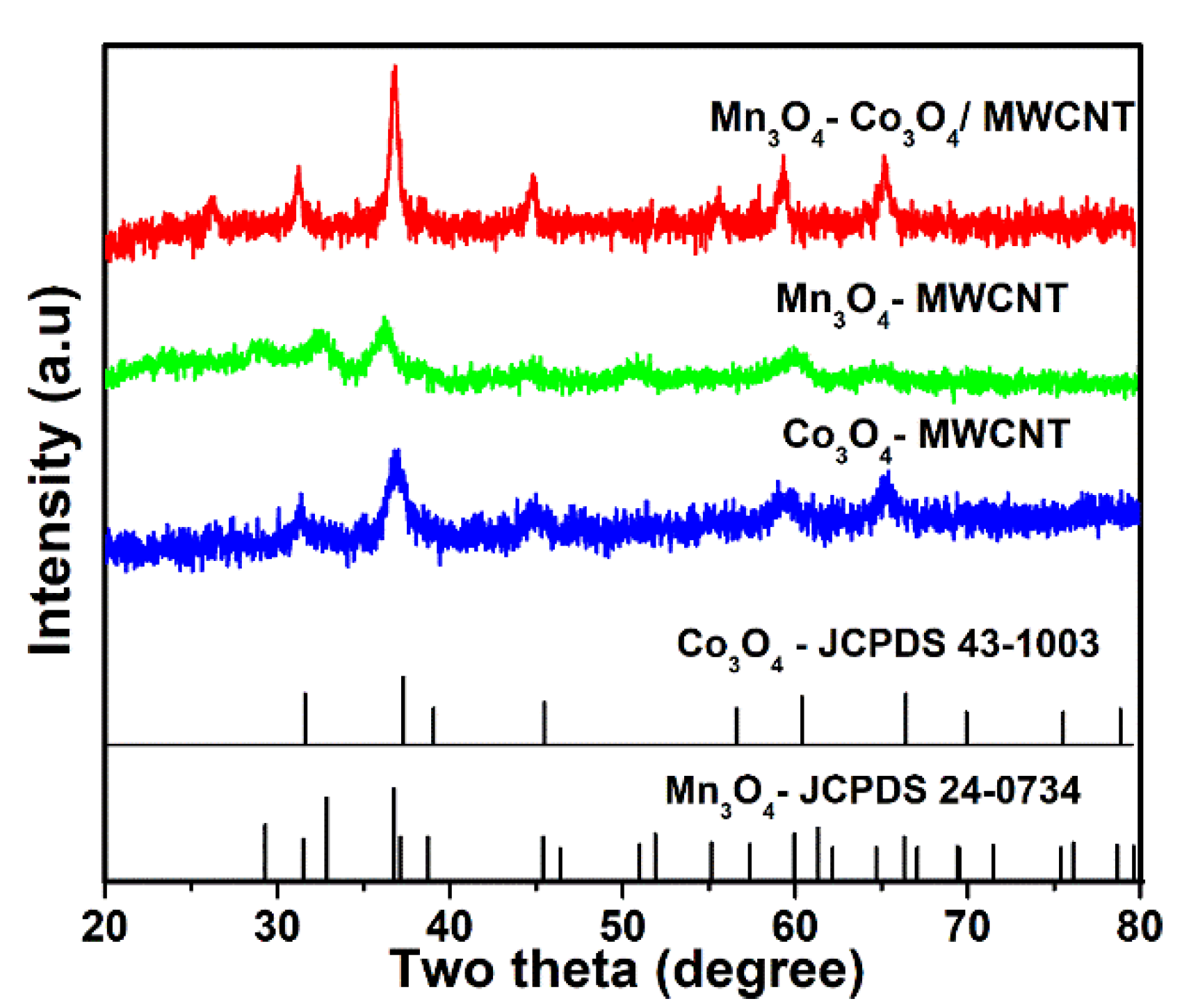
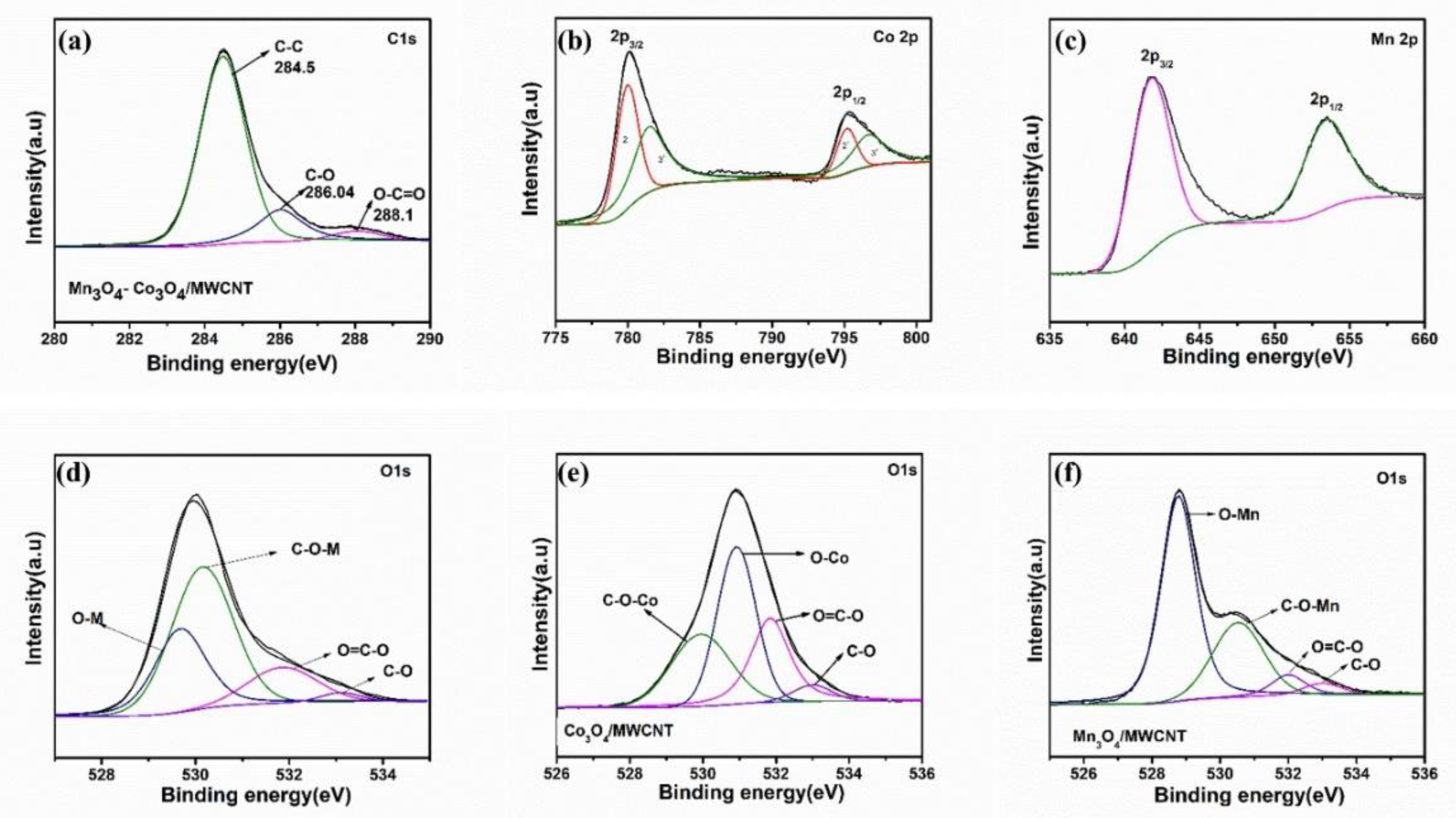
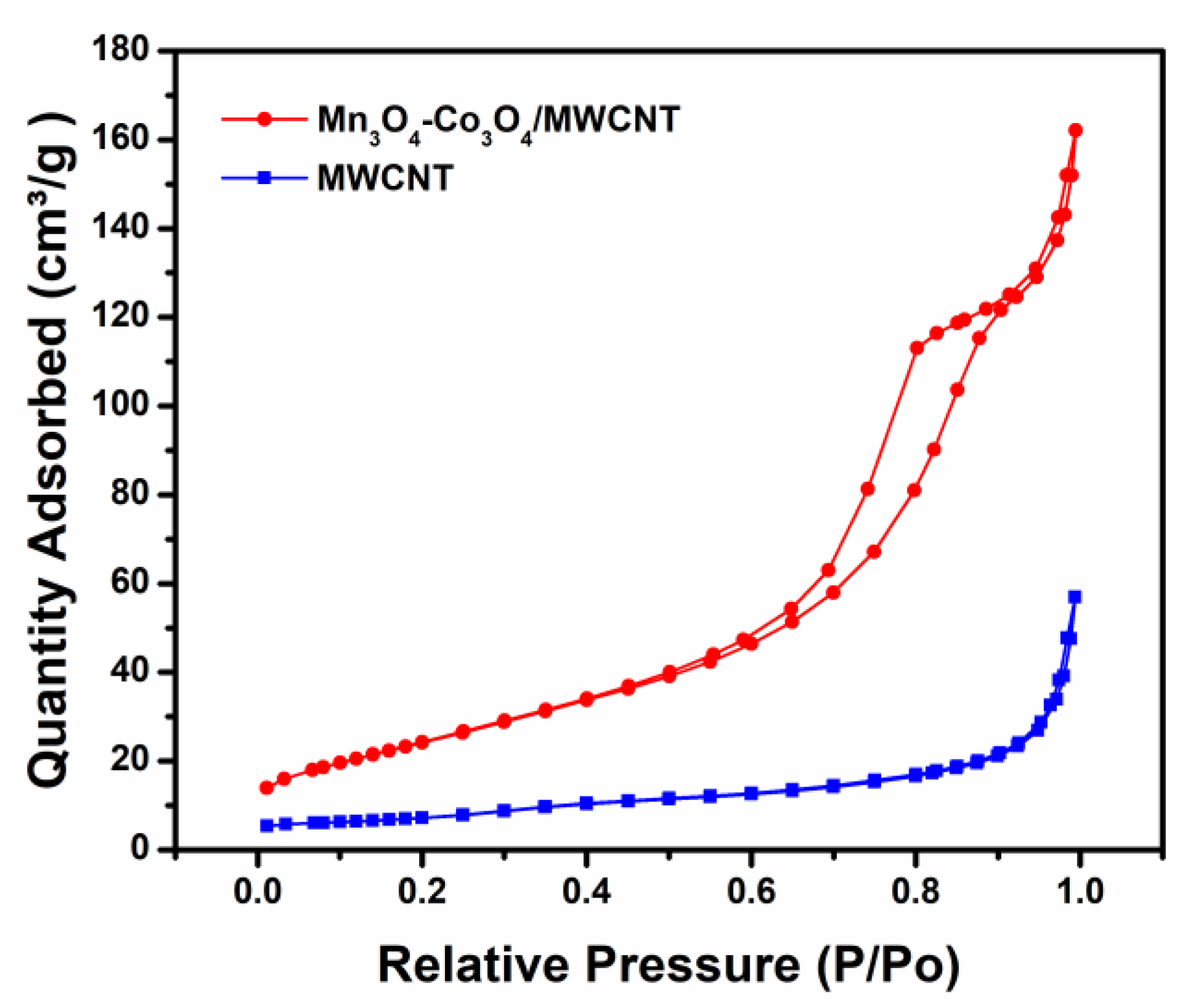
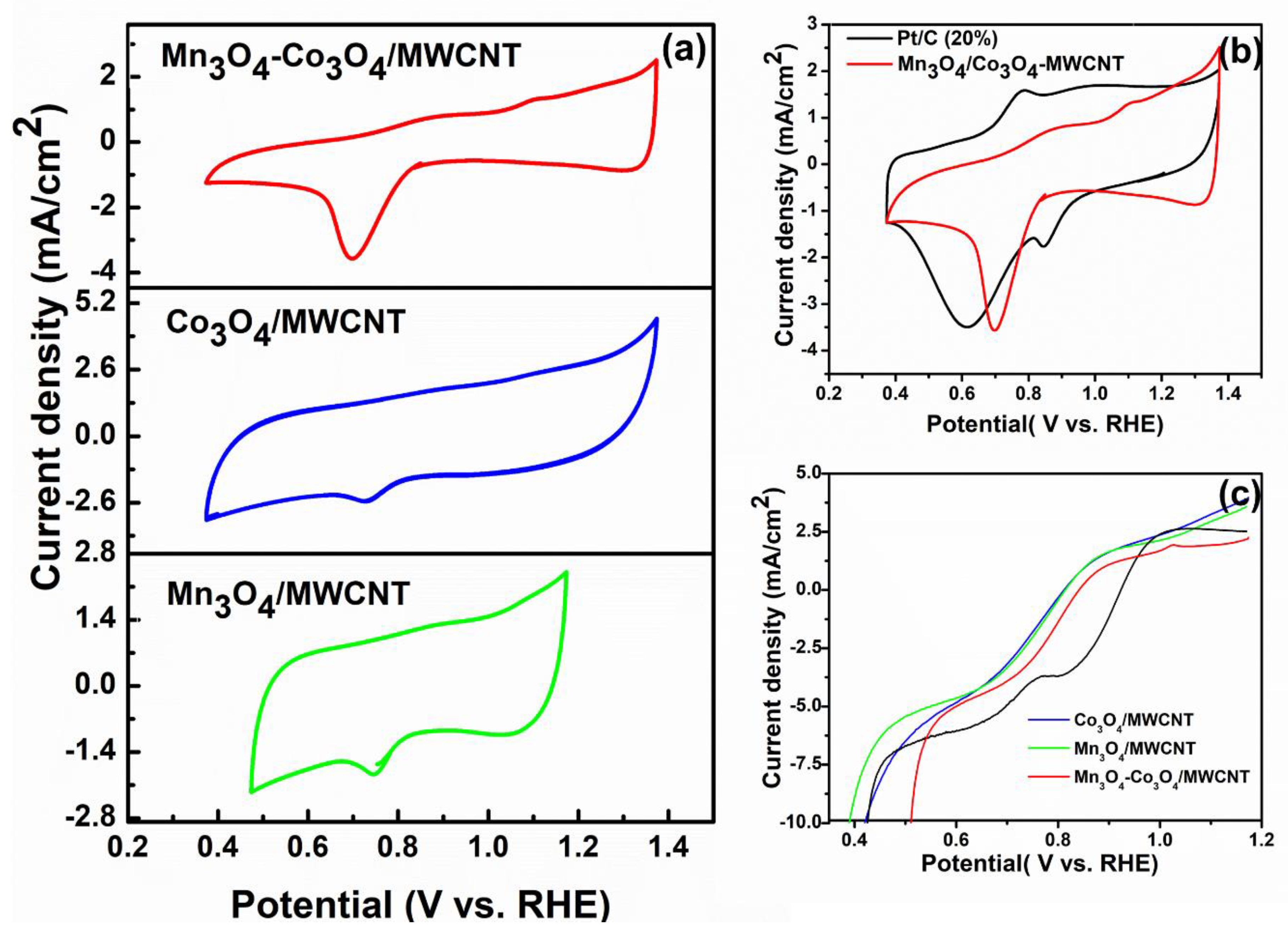

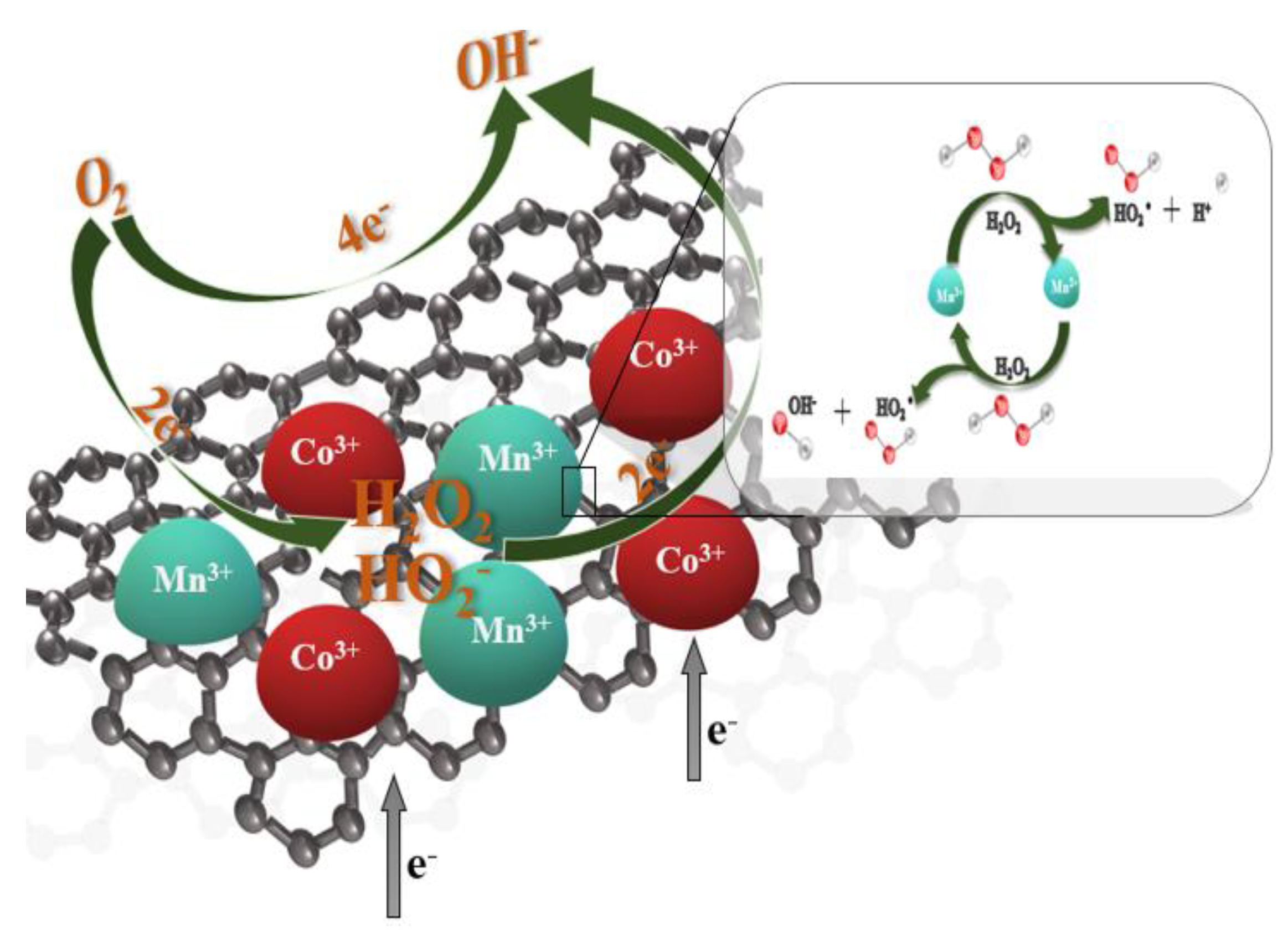
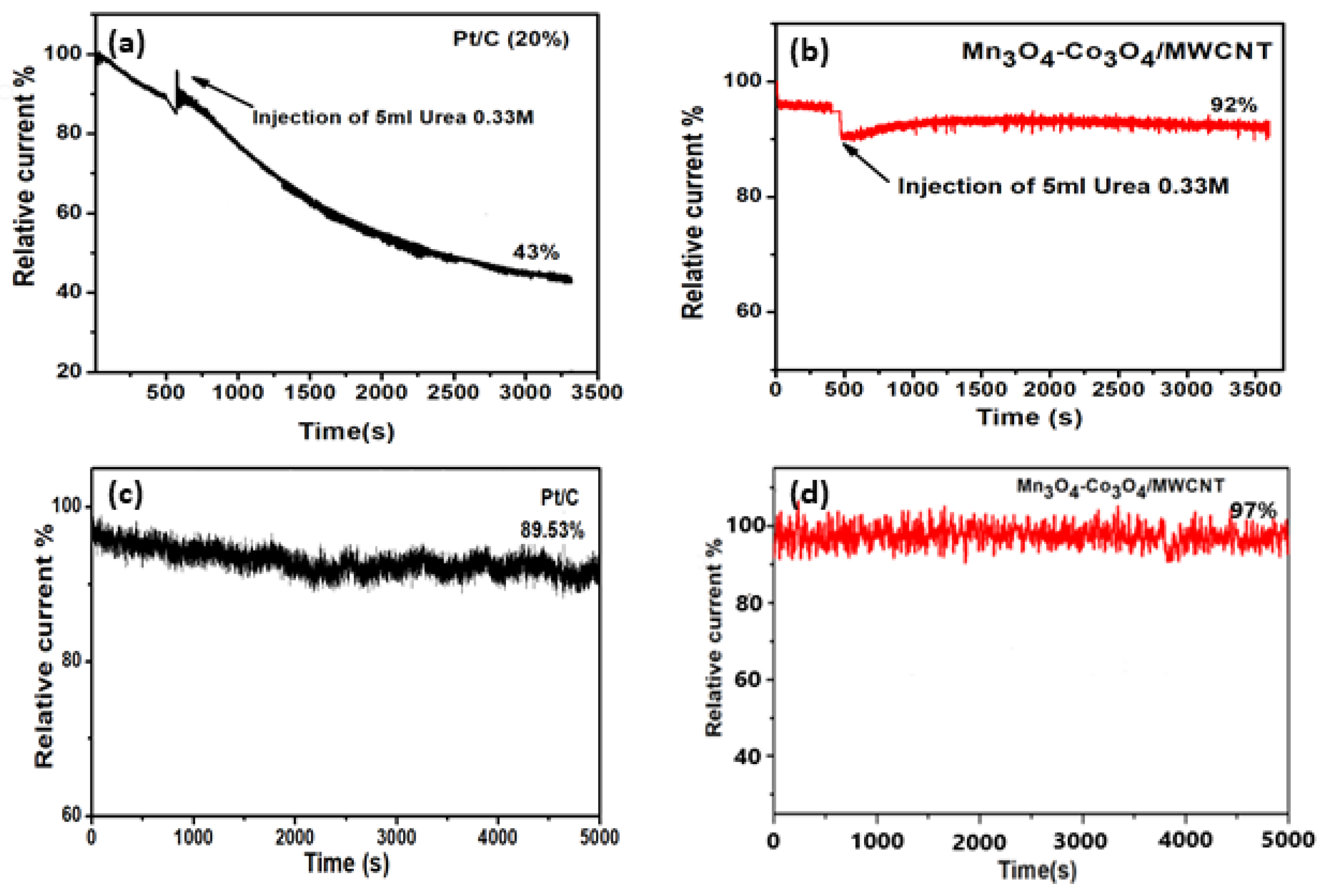
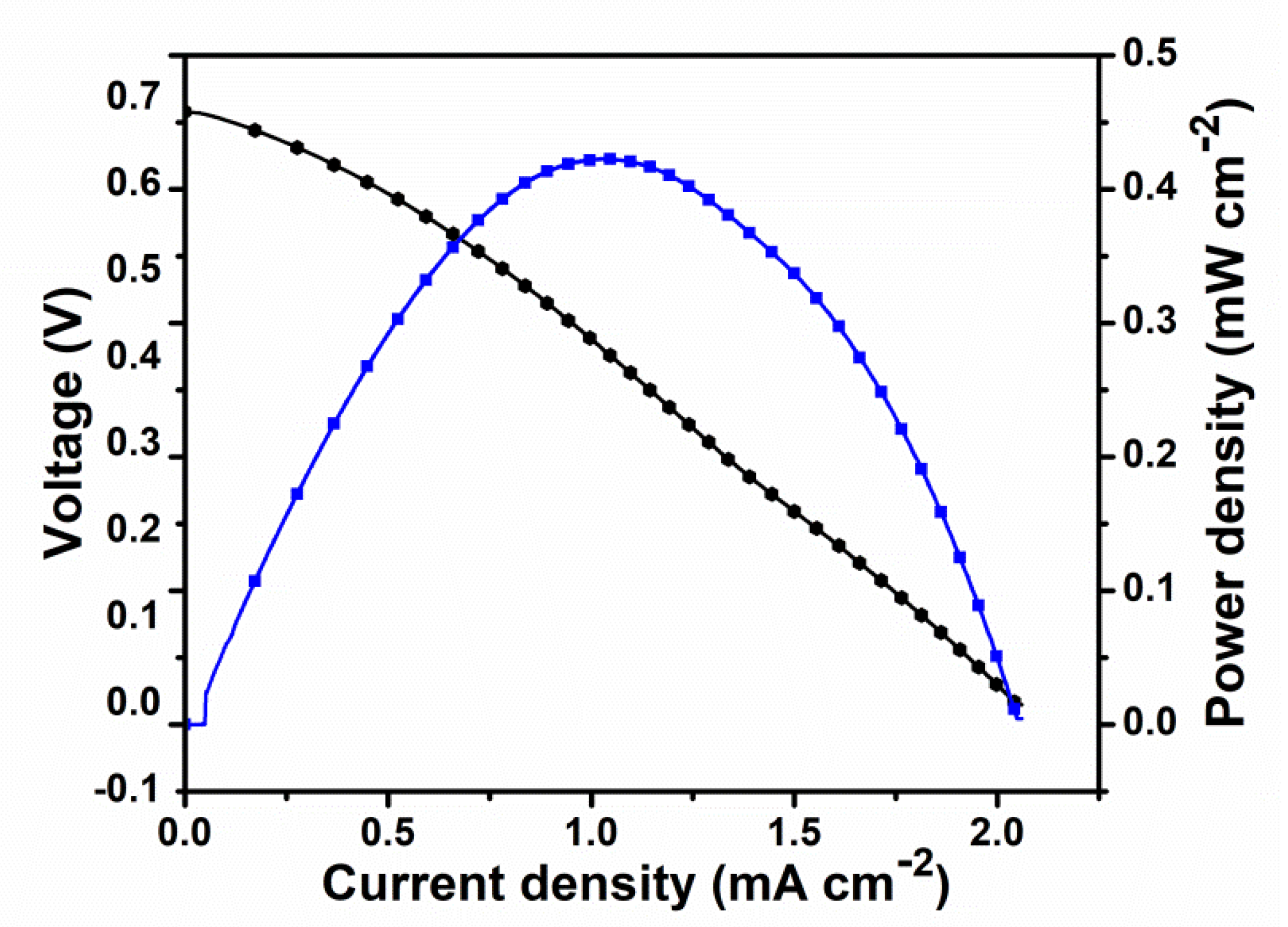
© 2020 by the authors. Licensee MDPI, Basel, Switzerland. This article is an open access article distributed under the terms and conditions of the Creative Commons Attribution (CC BY) license (http://creativecommons.org/licenses/by/4.0/).
Share and Cite
Pham, T.N.T.; Yoon, Y.S. Development of Nanosized Mn3O4-Co3O4 on Multiwalled Carbon Nanotubes for Cathode Catalyst in Urea Fuel Cell. Energies 2020, 13, 2322. https://doi.org/10.3390/en13092322
Pham TNT, Yoon YS. Development of Nanosized Mn3O4-Co3O4 on Multiwalled Carbon Nanotubes for Cathode Catalyst in Urea Fuel Cell. Energies. 2020; 13(9):2322. https://doi.org/10.3390/en13092322
Chicago/Turabian StylePham, Thi Ngoc Tuyen, and Young Soo Yoon. 2020. "Development of Nanosized Mn3O4-Co3O4 on Multiwalled Carbon Nanotubes for Cathode Catalyst in Urea Fuel Cell" Energies 13, no. 9: 2322. https://doi.org/10.3390/en13092322
APA StylePham, T. N. T., & Yoon, Y. S. (2020). Development of Nanosized Mn3O4-Co3O4 on Multiwalled Carbon Nanotubes for Cathode Catalyst in Urea Fuel Cell. Energies, 13(9), 2322. https://doi.org/10.3390/en13092322





